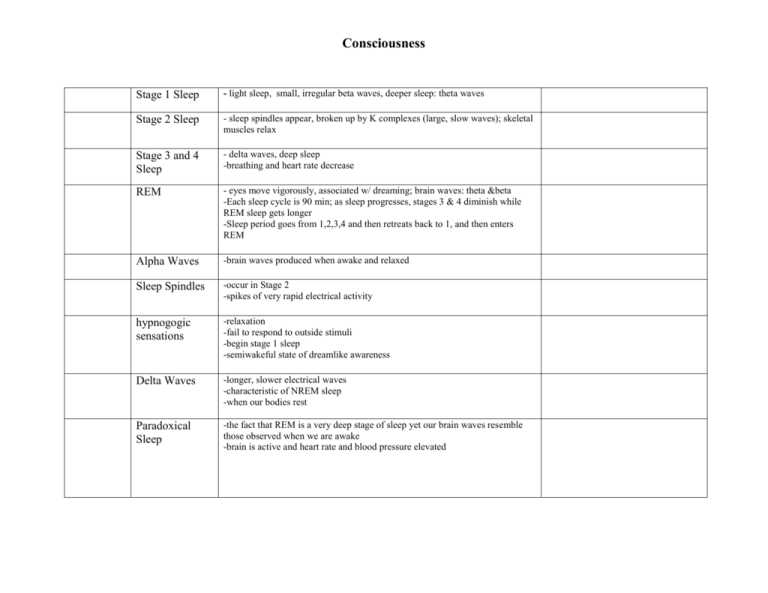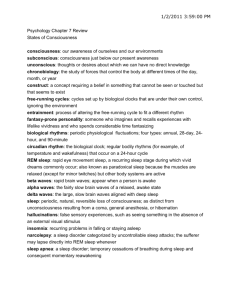Stage 1 Sleep
advertisement

Consciousness Stage 1 Sleep - light sleep, small, irregular beta waves, deeper sleep: theta waves Stage 2 Sleep - sleep spindles appear, broken up by K complexes (large, slow waves); skeletal muscles relax Stage 3 and 4 Sleep - delta waves, deep sleep -breathing and heart rate decrease REM - eyes move vigorously, associated w/ dreaming; brain waves: theta &beta -Each sleep cycle is 90 min; as sleep progresses, stages 3 & 4 diminish while REM sleep gets longer -Sleep period goes from 1,2,3,4 and then retreats back to 1, and then enters REM Alpha Waves -brain waves produced when awake and relaxed Sleep Spindles -occur in Stage 2 -spikes of very rapid electrical activity hypnogogic sensations -relaxation -fail to respond to outside stimuli -begin stage 1 sleep -semiwakeful state of dreamlike awareness Delta Waves -longer, slower electrical waves -characteristic of NREM sleep -when our bodies rest Paradoxical Sleep -the fact that REM is a very deep stage of sleep yet our brain waves resemble those observed when we are awake -brain is active and heart rate and blood pressure elevated Consciousness Night Terrors -characterized by a frightened awakening with high physiological arousal (sweating, increased heart and respiration rates) -little/no recall of event in the morning -NREM occurrences Sleep Apnea -sufferer frequently stops breathing during the night and must “re-start” himself, awakening himself to some degree but often without complete awareness -sometimes undiagnosed -correlated with obesity and may be linked to alcohol consumption Narcolepsy -inability to stay awake -sudden, involuntary drop into sleep -sufferer quickly enters REM Insomnia -lack of sleep: inability to fall asleep or maintain sleep -possible causes: stress, alcohol, stimulants REM Rebound -if (in a REM deprivation studied) an individual is awakened at the onset of each REM period for some time, and then is allowed to sleep normally, the sleeper tends to have longer REM periods -suggests that bodies need REM Dream Theory: Freudian (Latent and Manifest) Dream Theory (Activation Synthesis Hypothesis) -manifest content: superficial “plot” of the dream -latent content: more important, unconscious, symbolic underlying meaning of the dream -controversial -postulates that dreams are the product of our awareness of neural activity due to sensory input while we are sleeping -neural repair, consolidation of memory, and protein synthesis occur during dreams Consciousness “Facts and Falsehoods” of Hypnosis -hypnosis: altered state of consciousness in which the hypnotized person is very relaxed and open to suggestion -can be convinced that they see things that are not there or having experiences that they are not having -recall things they may otherwise may not have been able to recall -no recollection of hypnosis -not a real effect vs. participant living up to expectations of hypnotist Theories of Hypnosis 1) Neodissociative theory – hypnotist divides mind into two parts – one part obeys hypnotist while other part – the hidden observer – silently observes 2) Social Role Theory – hypnotized subject is acting out a social role consistent with the social situation; certain expectations of how to act and hypnotist gives instructions; subjects act according to guidelines; hidden observer gives permission to report pain various psychoactive drugs, their effects and classifications -psychoactive drugs – chemical substance that impacts behavior, perceptions, moods, or mental processes -4 broad categories: central nervous system (CNS) depressants, CNS stimulants, narcotics, and hallucinogens -depressants: alcohol, barbiturates, tranquilizers; slow nervous system activity, elevate mood, relax inhibitions, intoxicate -stimulants: caffeine, nicotine, amphetamines, cocaine; activate nervous system, speed up bodily function -narcotics: derived from opium plant: morphine, heroin; suppress pain, euphoria -hallucinogens: LSD, peyote, PCP; alter perceptions, sensory synesthesia




